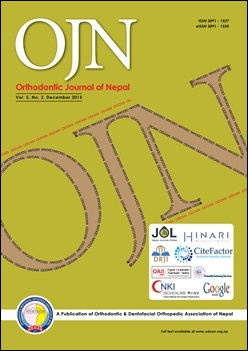Prevalence of Malocclusion in Western Nepal
DOI:
https://doi.org/10.3126/ojn.v5i2.15215Keywords:
gender variation, malocclusion, prevalenceAbstract
Introduction: Malocclusion is the improper relationship of maxillary and mandibular teeth. The prevalence of malocclusion varies in different populations of the world.
Objective: To study the prevalence of malocclusion in western part of Nepal and to evaluate the gender variation in occurrence of malocclusion.
Materials & Method: A total of 1284 subjects were studied. Out of them 656 were male and 628 were female. Intra-oral examination was carried out to assess occlusal types of Class I, II, III according to Angle’s classification of malocclusion, and various occlusal characteristics like crowding, spacing, cross-bite, open-bite and deep bite were recorded. Gender variation in malocclusion characteristics were tested using chi-square test (p<0.05).
Result: The present study showed that Class I occlusion type with malocclusion was more prevalent than Class II and Class III malocclusions. Class I was seen in 71.5% , Class II div 1 in 20.7%, Class II div 2 in 3.9% cases and Class III in 4.1% cases. Among the occlusal characteristics; crowding (61.3%), deep bite (29.5%) and spacing (10.5%) were most prevalent.
Conclusion: Class I malocclusion was most prevalent type of malocclusion in western Nepalese subjects. There was no significant gender dimorphism between male and female in prevalence of various malocclusion characteristics.
Downloads
Downloads
Published
How to Cite
Issue
Section
License
Copyright © held by Orthodontic & Dentofacial Orthopedic Association of Nepal
- Copyright on any research article is transferred in full to the Orthodontic & Dentofacial Orthopedic Association of Nepal upon publication in the journal. The copyright transfer includes the right to reproduce and distribute the article in any form of reproduction (printing, electronic media or any other form).
- Articles in the Orthodontic Journal of Nepal are Open Access articles published under the Creative Commons CC BY License (https://creativecommons.org/licenses/by/4.0/)
- This license permits use, distribution and reproduction in any medium, provided the original work is properly cited.




